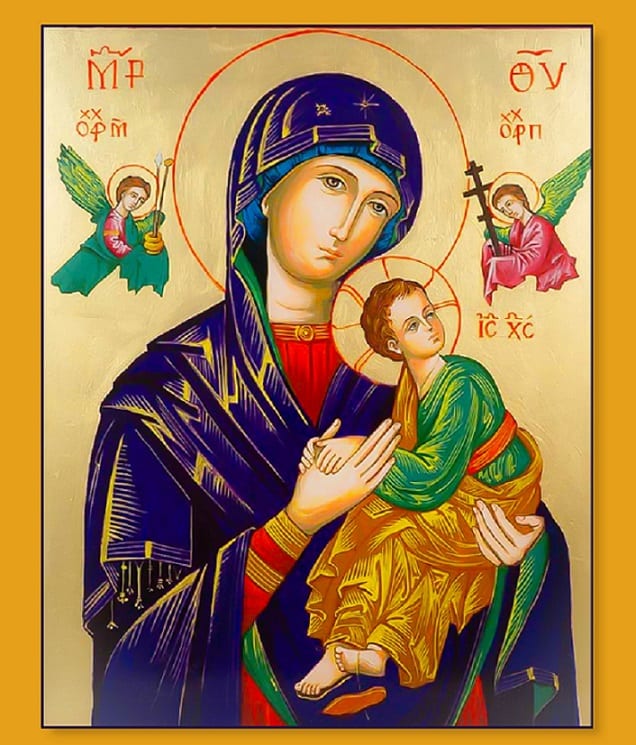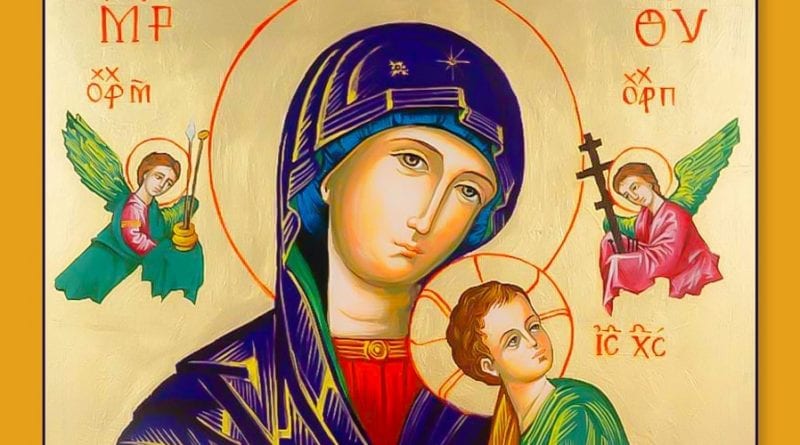Our Lady of Perpetual Help ~ Icon and Devotion
Byzantine Icon
The title, Our Lady of Perpetual Help, was given to Our Lady in association with her image in a 15th century Byzantine icon of the same name. The icon is known to be at least five hundred years old. Painted in tempera on wood, the earliest written account of the image comes from a Latin and Italian plaque placed in the church of San Mateo, Via Merulana where, in 1499, it was first venerated by the public. The writer of the icon is unknown, but some church legends say it may be the work of Saint Luke the Evangelist.
Disobeying a Dying Wish
Legend is that the icon was stolen by a merchant, from the island of Crete. He was sailing to Rome. While sailing, a ferocious storm arose. Sailors were frightened and prayed to the image for protection.
When he arrived in Rome, the merchant became ill and, as he lay dying, asked another merchant to place the icon in a church where it could be venerated. The second merchant told his wife of his friend’s dying request but when she saw the icon, she refused to give it to a church and instead, hung it in their home. Our Lady appeared to the merchant in a dream, telling him not to keep the icon. She appeared to him twice and both times he ignored her warning. She appeared a third time and told him that if he continued to disobey her, he would die a wretched death. The man became frightened and attempted to persuade his wife to give up the painting, but she refused. Mary appeared to him again and told him of his impending death; within a short time, he became sick and died.
Mary Appears ~ the Icon is Venerated
Our Lady then appeared to the couple’s young daughter and asked her to see that the icon was given to a church where it would be honored. It was given to the Augustinian Friars and in 1499, was transferred to the church of San Mateo (Saint Matthew,) in Genoa, Italy. Devoted crowds gathered to the Church of San Mateo and for nearly three hundred years, prayers were answered and favors were granted through the intercession of the Blessed Virgin. The icon, then, was called the Madonna di San Mateo.
Augustinian Monks Flee
In 1798, the Augustinian monks fled the city of Rome to avoid being captured by Napoleon’s invading armies. In an effort to keep the icon hidden, they took it to the nearby church of Saint Eusebius and later, to a side altar at Santa Maria Posterula, a small early medieval church near Rome.
Pope Pius IX Gives the Icon its Proper Home
Nicholas Mauron, the Father General of the Redemptorists, learned of this and brought the matter to the attention of Pope Pius IX who as a boy, prayed before the icon in San Mateo. Although the congregation was stationed on the Via Merulana, they did not realize that it was once the location of the church of San Mateo and the shrine of the icon. A priest of the Redemptorist order, who had heard stories of the icon and of the church in which it was once enshrined, told the pope of this matter and the decision was made to build the Church of Saint Alphonsus Liguori next to the site. The pope wanted the icon exposed to public veneration. In a letter to Father General Mauron, dated 11 December 1865, he ordered that Our Lady of Perpetual Succour (Our lady of Perpetual Help) should be again publicly venerated in Via Merulana, and this time at the new church of Saint Alphonsus. This was the first favor of the Holy Father towards the picture. On 26 April, 1866, he approved the solemn translation of the icon and its coronation. He fixed the feast as duplex secundae classis, on the Sunday before the Feast of the Nativity of Saint John the Baptist and by a decree dated May, 1876, approved a special office and Mass for the Congregation of the Most Holy Redeemer.
A Confraternity is Created
Learning that the devotion to Our Lady under this title had spread far and wide, Pius IX raised a confraternity of Our Lady of Perpetual Succour and ranked the church of Saint Alphonsus an arch-confraternity. He enhanced it with many privileges and indulgences. The Holy Father was among the first to visit the icon in its new home, and his name is the first in the register of the arch confraternity. Two thousand three hundred facsimiles of the Holy Picture have been sent from Saint Alphonsus’s church in Rome to every part of the world. At the present day not only altars, but churches and dioceses are dedicated to Our Lady of Perpetual Help.
Symbolism of the Image
The image shows the Blessed Virgin Mary wearing a dark red dress with a blue mantle and veil as she holds her Divine Child. In Byzantine icons, Mary is never shown without Jesus because He is central to the faith. Jesus is also wearing the clothes of royalty. The green tunic, red sash, and gold brocade portrayed in the image, could be worn only by an emperor. The Greek initials to the right of the child and his halo decorated with a cross proclaim that he is “Jesus Christ.” On the left is the Archangel Michael, carrying the lance and sponge of Jesus’ crucifixion. On the right, the Archangel Gabriel is carrying a three bar cross and nails. The Christ child is upset by a premonition of his passion and runs to his mother for comfort. The facial expression of Mary is somber as she looks directly at the viewer instead of her son. Jesus is portrayed clinging to her with a dangling sandal. The Greek initials on top read Mother of God, Michael Archangel, Gabriel Archangel, and Jesus Christ, respectively. Mary’s gaze is fixed outward, but her arms hold her Son. She takes us into the story and we become a part of the image. When frightened, the child, Jesus ran to her and she invites us to also, turn to her when we are troubled. Her hand is gracefully open, calling us to become one with her Son. Our Lady of Perpetual Help is commemorated on 27 June.
Prayer to Our Lady of Perpetual Help
O Mother of Perpetual Help, grant that I may ever invoke Thy most powerful name, which is the safeguard of the living and the salvation of the dying. O Purest Mary, O Sweetest Mary, let Thy name henceforth be ever on my lips. Delay not, O Blessed Lady, to help me whenever I call on Thee, for, in all my temptations, in all my needs, I shall never cease to call on Thee, ever repeating Thy sacred name, Mary, Mary. O what consolation, what sweetness, what confidence, what emotion fill my soul when I utter Thy sacred name, or even only think of Thee. I thank God for having given Thee, for my good, so sweet, so powerful, so lovely a name. But I will not be content with merely uttering Thy name; let my hope for Thee prompt me ever to hail Thee, Mother of Perpetual Help.
Marilyn Nash
http://www.Gardenias4Lina.com





